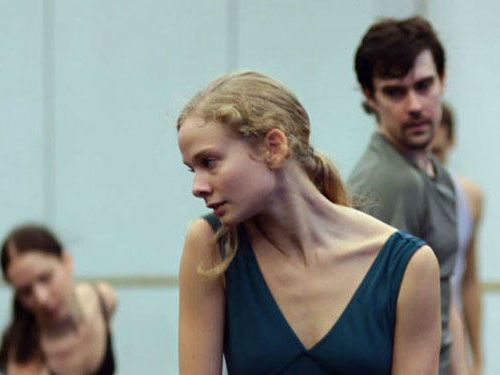
On 25th May 2011 the world-renowned Ballet de l’Opéra national de Paris presented Rain, its first ever performance of a choreography by Anne Teresa De Keersmaeker. The filmmakers Olivia Rochette and Gerard-Jan Claes followed the rehearsal process from the auditions to the opening performance. The documentary focuses on how De Keersmaeker and the Rosas dancers convey the dance idiom of the choreographer to the classically trained ballet dancers. The rigidity of ballet gives way to another kind of severity, namely the mathematical pattern of Rain, which, however, conceals a powerful emotional layering. A poetic documentary about searching, looking and hesitating within the walls of the opera, which at times can be claustrophobic.1
“Solicited by the Paris Opera, Anne Teresa De Keersmaeker agrees to put on a new production of Rain (2001) involving contemporary dance movements that at first seem alien to the illustrious French ballet company. The filmmakers were already familiar with the work of this choreographer, who had previously commissioned recordings from them, and they share her sense of rigour and sensuality. In this case, a mix of documentary sobriety and brief incursions into the realm of fiction, as when the camera lingers on the graceful beauty of one of the ballerinas, in defiance of the narrative thread and the Opera company’s rules (filming is all right, but not just one person). The editing thus switches between different types of images: the video of the first production of Rain that the troupe sometimes consults, shots from the Opera’s surveillance cameras, telephone conversations with the choreographer… The film acts as a curtain, like the minimal and undulating fringe of Rain’s Paris stage set. Through the things that are hidden from view, this fragmentary form suggests that beyond the technical learning process there is a more mysterious appropriation. A transmission only visible perhaps in the living present of the performance.”
Charlotte Garson2
« À la demande de l’Opéra de Paris, Anne Teresa De Keersmaeker accepte de monter à nouveau Rain (2001), dont la gestuelle contemporaine paraît a priori étrangère à l’illustre compagnie française. Familiers du travail de la chorégraphe qui leur a déjà commandé des captations, les réalisateurs partagent avec elle un goût de la rigueur et de la sensualité. En l’occurrence, sobriété documentaire et discrètes incursions romanesques, comme lorsque, faisant fi de la chronologie et des règles de la compagnie de l’Opéra (filmer, d’accord, mais pas une seule personne), la caméra s’attarde sur la beauté gracile de l’une des ballerines. Le montage alterne ainsi des régimes d’images différents : vidéo de la première création de Rain que consulte parfois la troupe, plans de caméras de surveillance de l’Opéra, conversations téléphoniques de la chorégraphe... Le film se fait rideau, semblable à la frange minimale et ondoyante du décor de Rain à Paris. Par ce qu’elle soustrait au regard, cette forme fragmentaire suggère qu’au-delà du travail technique d’apprentissage des pas, une appropriation plus mystérieuse a lieu. Une transmission visible seulement, peut-être, dans le présent vivant de la performance. »
Charlotte Garson3